- Home
- Dick Francis
Lester: The Official Biography Page 8
Lester: The Official Biography Read online
Page 8
From all these causes, a full-blown allergy had developed. Every time Lester was in any way involved in a fracas, official irritation against him took a larger step forward than the occurrence itself warranted. By 1954, the merest rumour of his involvement was producing automatic hostility, with steam coming down nostrils and the urge to squash erupting like a rash.
It took a very long time for this allergy to subside. In a later enquiry, for instance, Geoff Lewis was severely cautioned for giving evidence in Lester's favour and saying a collision had not been Lester's fault.
So in 1954 the avalanche of buried, unrecognised and unconsidered feelings rolled down the hill in civilised tones and did its brutal work. The unjust sentence was delivered.
Lester left home and went to Newmarket, stunned but again mostly silent, to work in the yard of Jack Jarvis. Jack Jarvis taught Lester none of the better ways he was supposedly there to learn, as the trainer was ill in bed most of the time and almost never left the house. Lester's cousin, Bill Rickaby, was Jack Jarvis's stable jockey, and Lester lived in Newmarket with his mother's sister and her husband, Mr. and Mrs. Fred Lane. This, the family thought, would most sympathetically and safely see Lester through his banishment from home.
Lester's terse opinion of the sentence was quoted at the time to be "unfair and ridiculous", (which can't have pleased his judges) and he has not changed his opinion since. Time has rubbed out the bitterness, but it was then, he says, that he really saw the world as it was.
What subsequently went on behind the scenes cannot be known, but suddenly towards the end of September the Stewards told Lester to reapply for his licence. The ban had lasted a week over three months.
During that time, Sir Gordon Richards had had a heavy fall and decided to retire, leaving trainer Noel Murless without the jockey whose services he had rejoiced in for very many years. A successor had to be found, and found soon. When Gordon retired, there were two full months left of the season. Owners who had horses trained by Noel Murless at that time included the Queen, Prince Aly Khan and Sir Victor Sassoon. It is certain that Noel wouldn't have engaged any jockey who was not acceptable to those owners and, equally, he wanted the best he could get.
Immediately Lester was told he could have back his licence, Noel invited him to be his stable jockey.
The step from depression to exhilaration was dramatic. Lester's licence was restored on 28 September, and the very next day he was back with a winner; and such was the fervour of the public's disgust with his suspension that the prolonged cheering of uninhibited affection practically lifted the roof off Newmarket's stands. Other wins followed on 1 and 2 October, and on 6 October at York, he won his first race for Noel Murless, on Evening Trial, owned by Sir Victor Sassoon.
Soon after, Lester rode and won for one of his Ascot judges. Bygones were all of a sudden definitely bygones. The allergy, well and truly scratched, had subsided. The road ahead again shone bright.
The successful come-back all the same exacted its price.
In the limbo of indefinite suspension at Jack Jarvis's, working as a stable-lad and not knowing at what point he should be fit for racing, Lester was unprepared for the suddenness of the reprieve. His weight through the months of banishment had edged upwards towards nine stone, and he was faced with the daunting task of losing one of these stones in a week. One stone represented one-ninth of his body: a body, moreover, with little flesh to spare. He achieved the loss on time through starvation, running and sweating, and still had enough strength to hold half a ton of horse on the wing.
Noel Murless had engaged a jockey who would put himself through wringers to win races. Noel Murless would settle for the odd bumping and boring charge that would surely lie ahead, if he could reserve for his stable that will, that skill, that unwavering passion.
-
8 Crepello, Carrozza and Petite Etoile
CREPELLO came into Noel Murless's yard as a yearling towards the end of 1955, and right from the beginning looked a horse with a sparkling future.
Inheriting Sir Gordon Richards' job at Warren Place, Noel Murless's great training establishment in Newmarket, Lester had a tremendous 1955 season, beating a century of winners for the first time and finishing third behind Doug Smith and Scobie Breasley on the jockeys' list.
The Never Say Die suspension was firmly behind him. The Never Say Die triumph in the Derby was what people remembered of 1954: the flashing presence rather than the disputed absence. While there were no Classic Piggott wins in 1955, there were others of interest, the biggest single prize being the Eclipse Stakes at Sandown, where Lester brought home Darius, which had finished third in Never Say Die's Derby.
On Nucleus, owned by Miss Dorothy Paget and trained by Helen Johnson Houghton at Blewbury in Berkshire (though the horses ran under the name of her friend, Charles Jerdein, as it was in the old-fashioned days before the jockey Club granted training licences to women) Lester won four races. The third of these wins was at Royal Ascot in the King Edward VII Stakes, a sweet victory, as it was in that race a year earlier that the Rashleigh/ Garter/Never Say Die collision occurred. The fourth Nucleus winner of the season was the prestigious jockey Club Stakes at Newmarket late in September.
Besides these, the year's highlights were Little Cloud's winning of the Northumberland Plate for Sir Victor Sassoon, and the same owner's Elope ment taking the Hardwicke Stakes at Royal Ascot, both horses trained by Noel Murless: and also Lester's first winner for the Queen, Annie Oakley at York in October.
Lester survived 1955 without a suspension or even a caution: perhaps everyone had learned something from the year before.
With the advent of the 1956 season, the training of both Crepello and Carrozza began in earnest. Crepello had been bred by Sir Victor Sassoon as a stayer to go two miles, being by Donatello II, who had won the Ascot Gold Cup. The colt was not, on his breeding, regarded as a top prospect for the Derby even though he had been prudently entered at birth for the big race.
A good-looking chestnut with a short neck on a big body, Crepello appeared as strong to the eye as he proved under the saddle. Always easy to ride, he would go without trouble wherever Lester wanted, and from very early on produced mouth-opening speeds on the gallops at home.
Training him was, in most respects, easy, but in one respect difficult: there was always the suspicion that one of the tendons in his forelegs would give way, which would mean effectively the end of his racing career. Accordingly throughout his life, Crepello wore strong supportive bandages on his forelegs, the sort called Newmarket Boots, which were made of doeskin and sewn on tightly, semipermanent. They had to be turned round on the legs every day to dislodge any piece of grit which might have slipped inside.
Noel Murless decided to run Crepello in June, which was fairly early for a juvenile of that breeding, and consequently sent him to Royal Ascot for the 5-furlong Windsor Castle Stakes. He told Lester to go carefully and not to push him too hard, and Lester, following instructions, was just beaten by the good Fulfer, trained by Geoffrey Brooke.
Lester's words: "Noel told me to be easy with him. I could have won otherwise. But I didn't punish him at all. It wouldn't have done him good for the future."
Noel was very pleased with the way Crepello ran, but instead of making haste to capitalise, he let down the colt for a while and brought him back to full training in September for the Middle Park Stakes at Newmarket. In that race, Crepello met some of the proven best of the season's two-yearolds, and was beaten into fourth place behind Pipe of Peace. The result was considered disappointing, even though the opposition had been stiff, the race fast and the distances at the end very short between the first four horses.
Noel Murless gave Crepello another rest and then ran him over seven furlongs in the Dewhurst Stakes, also at Newmarket, on 1 November. Crepello ran well and won by three-quarters of a length from the Queen's Doutelle, but still appeared not tremendously impressive.
"He was always a bit lazy," Lester says. "When he got to the fron
t, he never did more than he had to."
Noel Murless, nonetheless satisfied, put Crepello away for the winter after what had been a basically undemanding two-year-old programme, and concentrated on keeping the suspect legs strong for the heights ahead.
It's no easy matter to train a horse into tip-top form for the Two Thousand Guineas, run at Newmarket at the beginning of May, without a preliminary race first. Noel Murless, however, planned to do exactly that with Crepello, and feeling no doubt that it was now-or-never with the legs, galloped him hard and often on the Heath. The companions in these gallops were two good Murless four-year-olds and also the three-year-old Arctic Explorer, which Lester later that year took to victory in both the King Edward VII Stakes (again) and the Eclipse. The gallops were almost races in themselves, and by 1 May, the day of the Two Thousand Guineas, Noel Murless was confident that the colt was ready.
The Two Thousand Guineas turned out to be no easy race. For a start Crepello had the worst draw of all, number fifteen, on the outside. At Newmarket, the horses running the straight Rowley Mile come by preference down what is technically the outer rail of the track, that is to say, along the rail nearest to the stands. Crepello, drawn furthest away from the stands rail, was at a great disadvantage. Next, the opposition contained Pipe of Peace (the favourite) which had beaten Crepello on the same course the previous year, and also a good French horse, Tyrone, of which much was expected. Third, there were two delays to the start of the race, one horse bolting on the canter down, and three jockeys later being unseated by colliding with the starting tapes as the horses came under orders. Two of these horses were remounted, but Chevastrid decamped into the next parish and was eventually counted out.
When the race finally started, Lester solved the bad draw by coming over towards the stands rail, even though it meant tucking in near the rear of the field. There he stayed until he was nearing the Bushes, those few hawthorns on the far side of the track two or three furlongs from the winning post, where the horses meet rising ground.
At that point, Lester pulled Crepello out a little and shook him up; and he says, "I just went through them so easily, it was hard to believe".
Crepello reached the front but "went a bit lazy again", leaving Lester the task of holding off Pipe of Peace and the faster finishing Quorum (who in the end took second place), both horses having been at Crepello's heels for longer than was comfortable. The three battlers flashed across the line with no daylight between them, the official distances being half a length and a short head. The French horse Tyrone finished fourth, a good way back.
Crepello was immediately made favourite for the Derby, his reputation based not just on having won the Two Thousand Guineas, but on the persistence with which he'd fought off the challenge of Pipe of Peace over the last stages, and on the visible power and presence of his muscular body. Crepello, in fact, was exciting.
There has hardly been another horse of which more was confidently expected at Epsom, despite a pessimistic "knocking" campaign by a section of the Press.
"Finding one to beat Crepello" became the slightly mournful quest of would-be punters not liking the 6-4 available: and they would have been even less hopeful if they'd heard Lester's own opinion.
"Crepello worked very well before the Derby, as well as any horse I've ever seen. His gallops were terrific. He was one of the very best of horses."
Crepello went like a king to Epsom and with majesty took his crown. Lester let him go along easily in seventh or eighth place and as in the Guineas made no early move.
Coming round Tattenham Corner, he was tucked indistinguishably behind a cluster including Brioche, Eudaemon and Chevastrid (back from the next parish). Not until two furlongs out, as in the Guineas, did Lester move, and then, as before, the incredible acceleration set the stands roaring.
Crepello sliced through the Derby field and won by a length and a half in 2 minutes 352/5th seconds, only 13/5th seconds outside Mahmoud's longstanding 1936 record.
A few carping critics nevertheless said it hadn't been a "good" Derby because Crepello had beaten "nothing". But he had. The horse which finished second was the then little known Ballymoss, whose starry future victories included the Irish Derby, the St. Leger, the King George VI and Queen Elizabeth Stakes and the Prix de 1'Arc de Triomphe. Pipe of Peace again came third.
Sir Victor Sassoon had already won the Derby with Pinza, but he had bred Crepello, which made the second winner sweet. Plans were immediately laid for the St. Leger, with the King George and Queen Elizabeth Stakes along the way.
Crepello worked faultlessly again at home and went to Ascot for the King George as odds-on ante-post favourite. Then, while he stood waiting in the Ascot stables, the heavens opened and rain bucketed down on the racecourse. By the time of the first race, the going was "heavy".
Noel Murless struggled with a dilemma. The ante-post market meant that if he withdrew the horse, those who had already backed him would lose their money. If he ran the horse, the tug of the sticky turf might be too much for the suspect tendons.
The legs had so far stood up to everything asked of them, but always on good ground.
For the sake of Crepello, for the sake perhaps of the St. Leger and the Triple Crown, Noel Murless withdrew him an hour before the big race. The decision was greeted with howls of rage by the disappointed crowd and with resignation by Lester. The horse went home sound to Newmarket and was given a short rest before preparing for the St. Leger.
It was then, after a gallop at home, that the worst happened. Crepello went irretrievably lame, the tendon stretching ominously, ready to tear if stressed. The days of speed and glory were depressingly over.
Crepello ran in only five races in his life. Lester puts him in the top five horses he ever rode, and thinks he would have been unbeaten after the Derby. At stud, perhaps because of his own longdistance breeding, Crepello was not immediately notable.
His colt foals were in general moderate, the fillies better. The fillies went on to make good brood-mares, and themselves produced many winners.
Noel Murless's stable in 1957 was solidly packed with outstanding equine talent, but all of his lesser horses ran into winning form also, as if inspired by the great. The mystery of being "in form" can never be scientifically explained, but when the heavens smile it's best not to waste time.
Lester's sixth winner of the season was Carrozza for the Queen in the Princess Elizabeth Stakes at Epsom in April, an early announcement if ever there was one of the filly's intentions. Despite her small size-a shade under 15 hands-she proved game and determined throughout her career.
By Dante, Carrozza was owned by the National Stud and leased by Her Majesty, an arrangement common for many years. Latterly, the National Stud (theoretically owned by the taxpayers) has kept only stallions and brood-mares, with no horses of tip-top racing age. The Queen for years sent the National Stud horses to Noel Murless to train, while those she herself owned were with Sir Cecil Boyd Rochfort.
During 1956, Carrozza as a two-year-old had won early on for Noel Murless at Hurst Park, ridden by Lester, but in general there was more public interest in the Queen's very own filly of the same age, Mulberry Harbour. After her early twoyear-old win, besides, Carrozza was off the racecourse for weeks, having tangled with her rug in her box at home, injuring herself severely.
In 1957, after her first three-year-old win, she ran with promise but without distinction to finish fourth in the One Thousand Guineas (ridden by Bill Rickaby) and it was Mulberry Harbour who went to the Oaks with more expected. Mulberry Harbour carried the Queen's first colours: Harry Carr wore the black velvet cap with the gold fringe, while Lester's cap was white with a gold tassel. Neither was favourite, that honour going to the Aga Khan's French-trained filly Rose Royale II at 11-10. Mulberry Harbour, next best, set off at 11-4.
In the race itself, however, Mulberry Harbour faded unusually under pressure, having rounded Tattenham Corner in a good second position. Carrozza, going well, came down the hill agai
nst the rails with two or three others in front. One of those, Taittinger, well fancied, tired a little and came away from the rails, leaving a gap.
Lester took Carrozza through it like a dart before the crowd could draw breath and they were suddenly out in front, sprinting for home.
The favourite Rose Royale II took up the battle, but couldn't pass. An Irish horse, Silken Glider, ridden by Jimmy Eddery (father of Pat, Paul, Michael and David) next got into top gear and began overhauling Carrozza. The crowd held its breath. Lester kept little Carrozza going with every resource of his artistry, with Silken Glider gaining inexorably. So close were they as they passed the post that neither jockey was certain who had won, though in three strides more there would have been no problem as Silken Glider shot ahead before pulling up.
The judge called for a photograph, and after a nail-biting pause Carrozza was named the winner by a short head. The Queen, to delighted applause, led in her first Classic winner and people began searching for new adjectives to apply to Lester.

 Bolt
Bolt Proof
Proof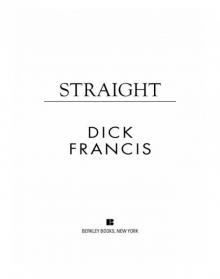 Straight
Straight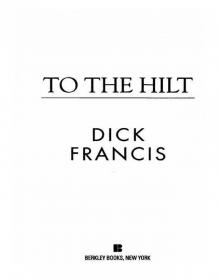 To the Hilt
To the Hilt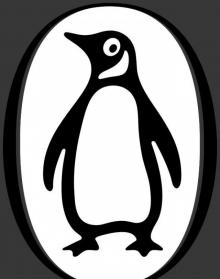 High Stakes
High Stakes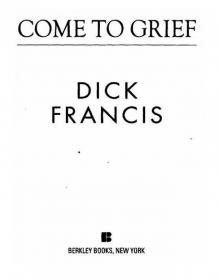 Come to Grief
Come to Grief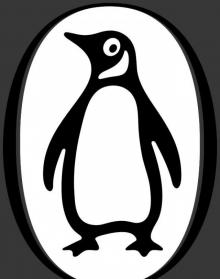 Odds Against
Odds Against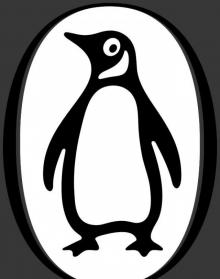 Knock Down
Knock Down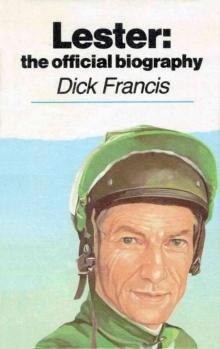 Lester: The Official Biography
Lester: The Official Biography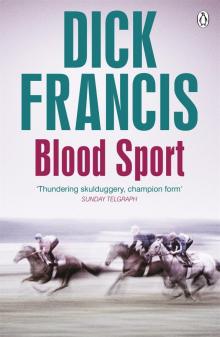 Blood Sport
Blood Sport Trial Run
Trial Run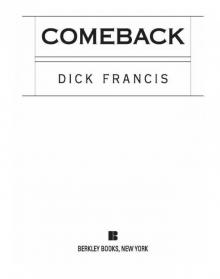 Comeback
Comeback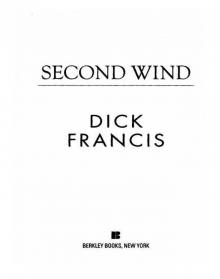 Second Wind
Second Wind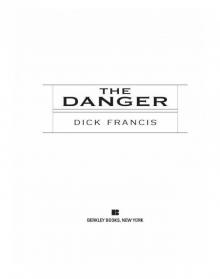 The Danger
The Danger Under Orders sh-4
Under Orders sh-4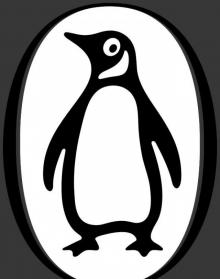 Break In
Break In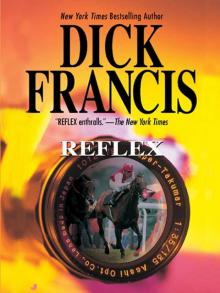 Reflex
Reflex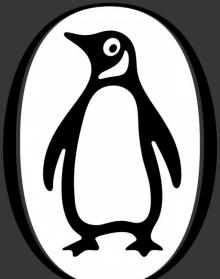 Dead Heat
Dead Heat Dick Francis's Damage
Dick Francis's Damage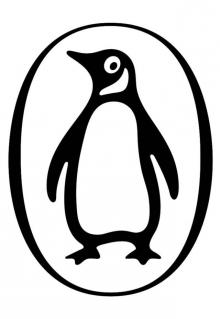 The Edge
The Edge Wild Horses
Wild Horses Longshot
Longshot Slay Ride
Slay Ride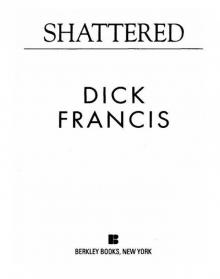 Shattered
Shattered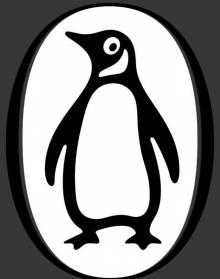 Banker
Banker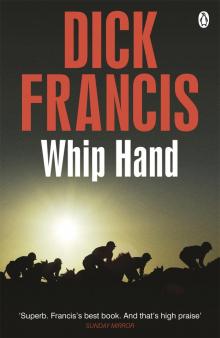 Whip Hand
Whip Hand Even Money
Even Money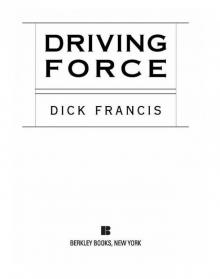 Driving Force
Driving Force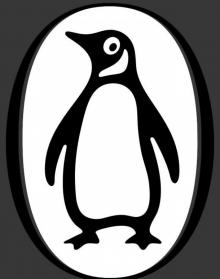 Decider
Decider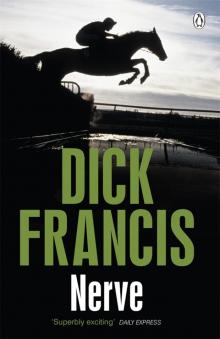 Nerve
Nerve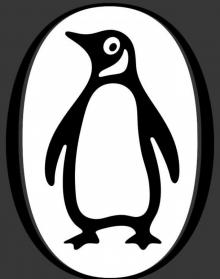 Hot Money
Hot Money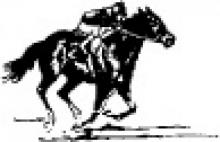 Field of Thirteen
Field of Thirteen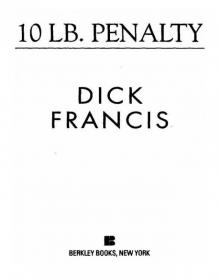 10 lb Penalty
10 lb Penalty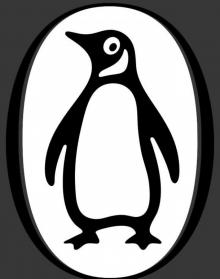 Dead Cert
Dead Cert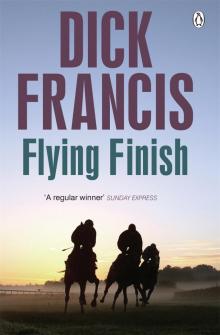 Flying Finish
Flying Finish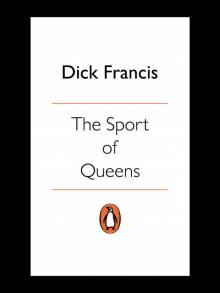 The Sport of Queens
The Sport of Queens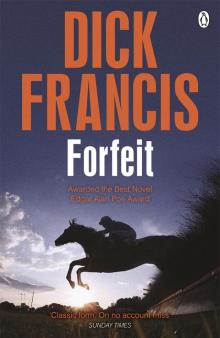 Forfeit
Forfeit Smokescreen
Smokescreen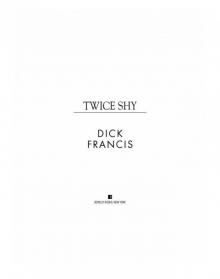 Twice Shy
Twice Shy Silks
Silks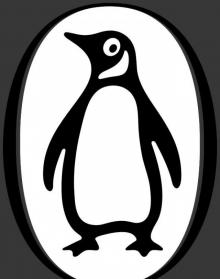 Enquiry
Enquiry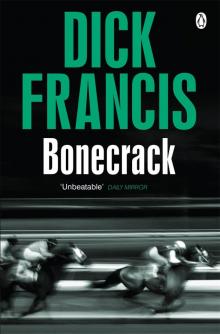 Bonecrack
Bonecrack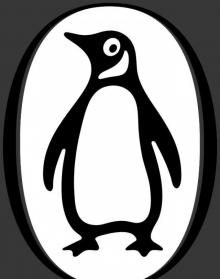 For Kicks
For Kicks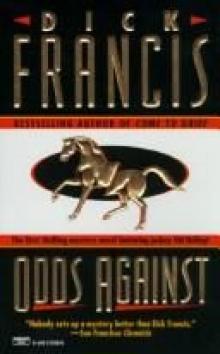 Odds against sh-1
Odds against sh-1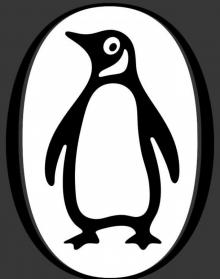 Rat Race
Rat Race Crossfire
Crossfire